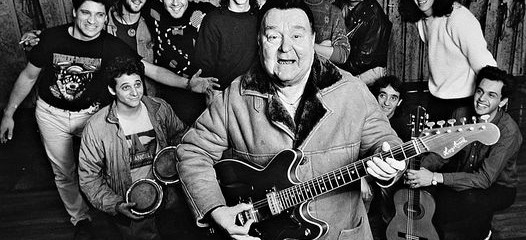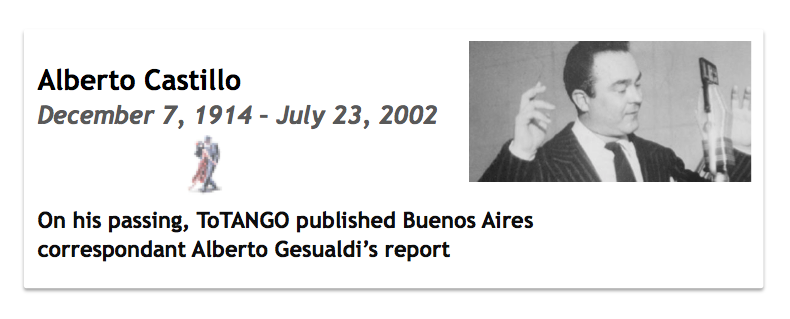Yesterday, July 23th, a great singer passed away.
His real name was Alberto Salvador de Lucca, and he was born on December 7th, 1914, the fifth son of Italian parents, the immigrants Salvador de Lucca and Lucia Paola.
He had to hide from his father his performances singing tango at the local radio stations, so he adopted nicknames: Alberto Dual and also Carlos Duval. He continued singing with the orchestras of Julio De Caro (1934), Augusto Pedro Berto (1935) and Mariano Rodas (1937).
In 1938, he left music and studied hard for a career as physician. But tango had still the sting in him, and one year before his graduation he joined the legendary tipica orchestra "The Indians" under the direction of Tanturi, an odontologist and piano player.
The first record of Tanturi-Castillo appeared on January 8th, 1941. Alberto adopted his last and everlasting nickname: Alberto Castillo. His first hit was the vals "Recuerdo" from Alfredo Pelaia.
A year later, he graduated as gynecologist, and opened his consulting room at his parents' house.
Therefore, every evening, the Doctor Alberto Salvador De Lucca would rush from his "ladies consultig room" to the radio to make his live broadcasts as the singer Alberto Castillo. The situation got entangled when the waiting room of his office began to be flooded with women, mostly young. There was an explanation for this: the singer attracted a lot of fans, and soon they discovered that the physician De Lucca and the singer Castillo were the same person.
Castillo himself remembered a funny situation, when he was attending a lady at his consulting room, waiting for her to undress for the consultation. "Madam, are you ready?" he asked the young lady who was behind a curtain. "Yes, doctor, I already am. Are you ready, too? " answered the young patient with total cheek/nerve.
On June 6th, 1945, he married Ofelia Oneto. They had three children, Alberto Jorge (gynecologist and obstetrician), Viviana Ofelia (veterinarian and agro engineer) and Gustavo Alberto (plastic surgeon). Those were the days of a tremendous success for Castiilo, he was an authentic popular idol.
His way to move on the stage, his way to take the microphone and swing it from one side to other side, his always elegant attire - usually with light/cream suits, his right hand near his mouth as if he was voicing as a newspaper vendor on the streets, his handkerchief falling from the pocket of his suit, the neck of the shirt unbuttoned and the tie loose. Everything was unusual, uncommon, everything caused sensation, even his improvised fist fights with some "pitucos/cry babies" of the audience, when he sang the theme "Que saben los pitucos!" (the first line of the tango "Asi se baila el tango"), that made some of the crybabies of the audiences give cat calls. Castillo simply stepped down from the stage, engaged in a exchange of fist fight with the crybabies, and set up again, singing while his attire was a bit messy by the fight.
Some time after, he left Tantur, and began experimenting with candombe, introducing these songs in his shows, using black dancers while he sang. The first candombe hit was "Charol" a success in Buenos Aires and also in Montevideo. Castillo decided to continue introducing candombe songs, including his still famous "Siga el baile" (from Carlos Warren and Edgardo Donato).
Also "Baile de los morenos", "El cachivachero" and, among others, "Candonga", this last one composed by himself.
Castillo was also a tango lyrics writer: "Yo soy de la vieja ola", "Muchachos, escuchen", "Cucusita", "Así canta Buenos Aires", "Un regalo del cielo", "A Chirolita", "Dónde me quieren llevar!", "Castañuelas" y "Cada día canta més"; and the marches "La perinola" and "Año nuevo".
(Keith: His 50s records were arranged and lead by the incomparable Emilio Balcarce - which makes them worth having.)
He also appeared as an actor in pictures such as in 1946 with "Adiós pampa mía", and later on 1948 "El tango vuelve a París" (joined by Aníbal Troilo), "Un tropezón cualquiera da en la vida" (with Virginia Luque), "Alma de bohemio" , "La barra de la esquina" (1950), "Buenos Aires, mi tierra querida" (1951), "Por cuatro días locos" (1953), "Ritmo, amor y picardía", "Música, alegría y amor", "Luces de candilejas" (1955, 1956 y 1958 this last three, joined by the extraordinary rumba dancer Amelita Vargas) and "Nubes de humo" (1959).
The last hit of Castillo was in 1993, when he recorded "Siga el baile" with the Argentine rock group"Los Auténticos Decadentes" and managed to capture the young people of the end of the XX century, as well as he managed before with the ones of the '40 s.
I personally have the pleasure to dance at the Centro Cultural Torcuato Tasso, last year, when he came to sing to this place. He was walking with some difficulty, and had to be helped to step on to the stage. But, once over the stage, he captured all the audience, and sang for almost one hour without interruption. It was an unforgettable experience, to share the dancing with a lot of young people that came to see him.
He will be remembered as an authentic singer, one that sang for the people to dance, and also was a kind and humble man.
He liked to start his shows saying "I belong to the people, from the people I receive all what I am, and to the people I give all what I can."


